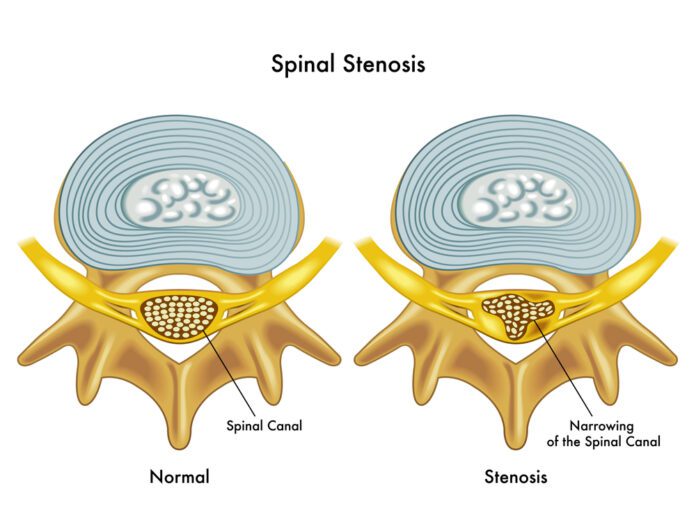Overview Of Spinal Stenosis
Spinal stenosis is the narrowing of the spinal column that causes pressure on the spinal cord or narrowing of the openings (called neural foramina) where spinal nerves leave the spinal column.
Commonly Associated With
Pseudo-claudication; Central spinal stenosis; Foraminal spinal stenosis; Degenerative spine disease; Back pain – spinal stenosis; Low back pain – stenosis; LBP – stenosis
Causes Of Spinal Stenosis
Spinal stenosis usually occurs as a person ages, however, some patients are born with less space for their spinal cord.
- The spinal disks become drier and start to bulge.
- The bones and ligaments of the spine thicken or grow larger. This is caused by arthritis or long-term swelling.
Spinal stenosis may also be caused by:
- Arthritis of the spine, usually in middle-aged or older people
- Bone diseases, such as Paget disease
- Defect or growth in the spine that was present from birth
- Narrow spinal canal that the person was born with
- Herniated or slipped disk, which often happened in the past
- Injury that causes pressure on the nerve roots or the spinal cord
- Tumors in the spine
- Fracture or injury of a spinal bone
Symptoms Of Spinal Stenosis
Symptoms often get worse slowly over time. Most often, symptoms will be on one side of the body but may involve both legs.
Symptoms include:
- Numbness, cramping, or pain in the back, buttocks, thighs, or calves, or in the neck, shoulders, or arms
- Weakness of part of a leg or arm
- Symptoms are more likely to be present or get worse when you stand or walk. They often lessen or disappear when you sit down or lean forward. Most people with spinal stenosis cannot walk for a long period.
More serious symptoms include:
- Difficulty or poor balance when walking
- Problems controlling urine or bowel movements
Exams & Tests
During a physical exam for spinal stenosis, your health care provider will try to find the location of the pain and learn how it affects your movement. You will be asked to:
- Sit, stand, and walk. While you walk, your provider may ask you to try walking on your toes and then your heels.
- Bend forward, backward, and sideways. Your pain may worsen with these movements.
- Lift your legs straight up while lying down. If the pain is worse when you do this, you may have sciatica, especially if you also feel numbness or tingling in one of your legs.
- Your provider will also move your legs in different positions, including bending and straightening your knees. This is to check your strength and ability to move.
- To test nerve function, your provider will use a rubber hammer to check your reflexes. To test how well your nerves sense feeling, your provider will touch your legs in many places with a pin, cotton swab, or feather. To check your balance, your provider will ask you to close your eyes while keeping your feet together.
A brain and nervous system (neurologic) examination helps confirm leg weakness and loss of sensation in the legs. You may have the following tests:
- Spinal MRI or spinal CT scan
- X-ray of the spine
- Electromyography (EMG)
Treatment Of Spinal Stenosis
Your provider and other health professionals will help you manage your pain and keep you as active as possible.
- Your provider may refer you for physical therapy. The physical therapist will teach you stretches and exercises that make your back muscles stronger.
- You may also see a chiropractor, a massage therapist, and someone who performs acupuncture. Sometimes, a few visits will help your back or neck pain.
- Cold packs and heat therapy may help your pain during flare-ups.
Treatments for back pain caused by spinal stenosis include:
- Medicines to help relieve back pain.
- A type of talk therapy called cognitive behavioral therapy to help you better understand your pain and teach you how to manage back pain.
- An epidural spinal injection (ESI), which involves injecting medicine directly into space around your spinal nerves or spinal cord.
- Spinal stenosis symptoms often become worse over time, but this may happen slowly. If the pain does not respond to these treatments, or you lose movement or feeling, you may need surgery.
- Surgery is done to relieve pressure on the nerves or spinal cord.
- You and your provider can decide when you need to have surgery for these symptoms.
- Surgery may include removing a bulging disk, removing part of the vertebra bone, or widening the canal and openings where your spinal nerves are located.
During some spinal surgeries, the surgeon will remove some bone to create more room for your spinal nerves or spinal column. The surgeon will then fuse some of the spine bones to make your spine more stable. But this will make your back more stiff and cause arthritis in areas above or below your fused spine.



